By Author & Photographer: Keith Williams
Founder, Freshwater Journeys
Executive Director, NorthBay
The traffic was heavier than I expected as I pulled onto the small, one lane in places, dirt road that follows Fishing Creek downstream for a few miles. I should have known a lot of people would be out. It was a beautiful early April day, with warm sun shining through the canopy that was just starting to leaf out, and pale blushes of yellow, green and pink painted the winter bare brown and grey branches before a clean blue sky, all without blemish.
A pretty normal early spring day except it wasn’t. Overhanging all of this serenity was the threat of Covid-19, and the fear and difficulties this disease has brought. Fear around physical and financial health, and the physical and emotional toll being in quarantine exacts. It was no surprise Fishing Creek was flooded with people. The power of nature is apparent now, as people are heading to trails, parks and preserves in record numbers for solace. But these natural places have limits on what they can endure. Those limits are being reached, and in many cases exceeded. It’s this crazy balance of wanting people to get out in nature, to benefit from her healing and reassurance, but too many of us in one place results in the destruction of the very nature we need. Sounds like a microcosm for the larger planetary struggle. And it’s a microcosm and local example of the power of one and unintended consequences.
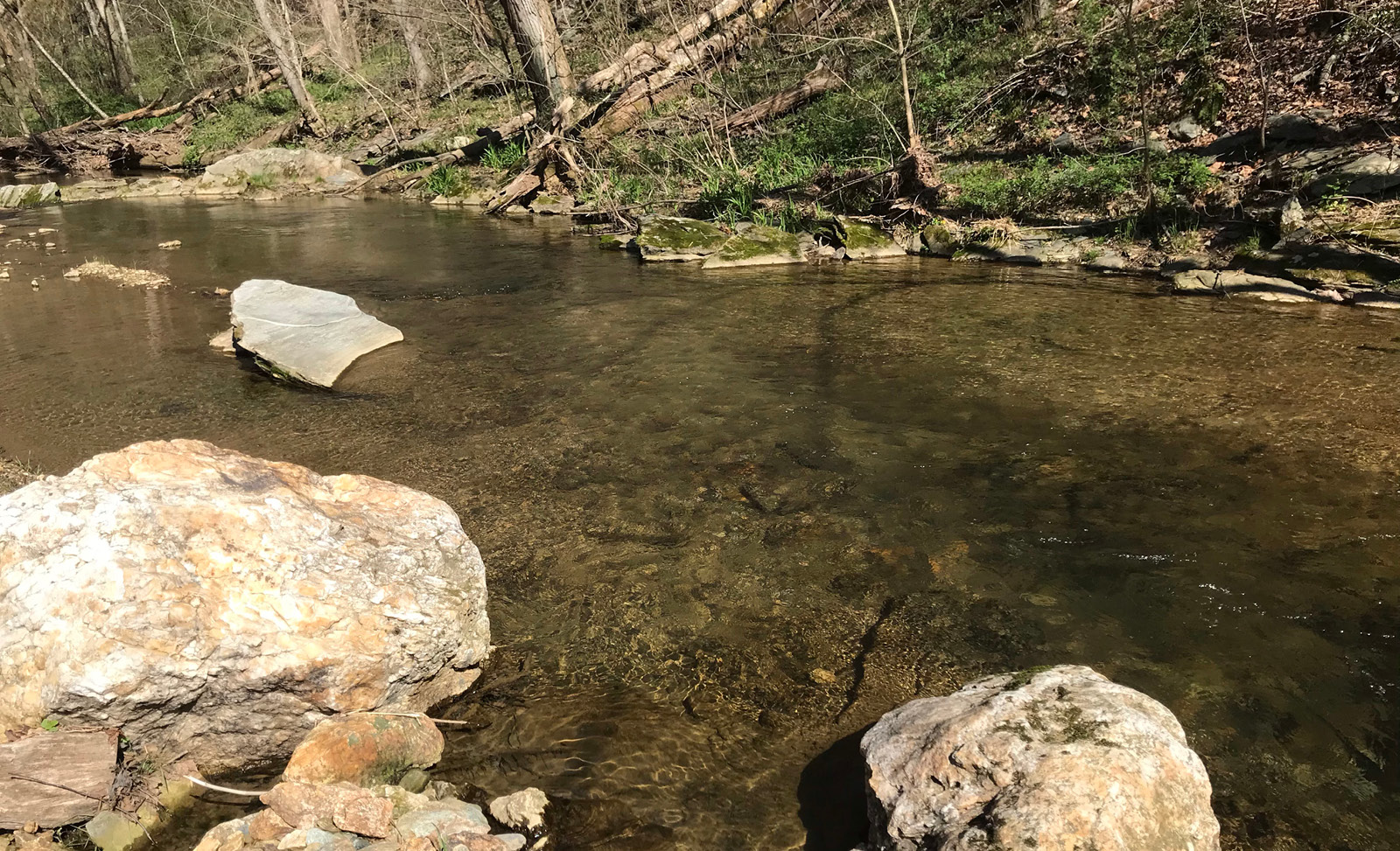 Clear water at Fishing Creek before illegal four-wheeling activity.
Clear water at Fishing Creek before illegal four-wheeling activity.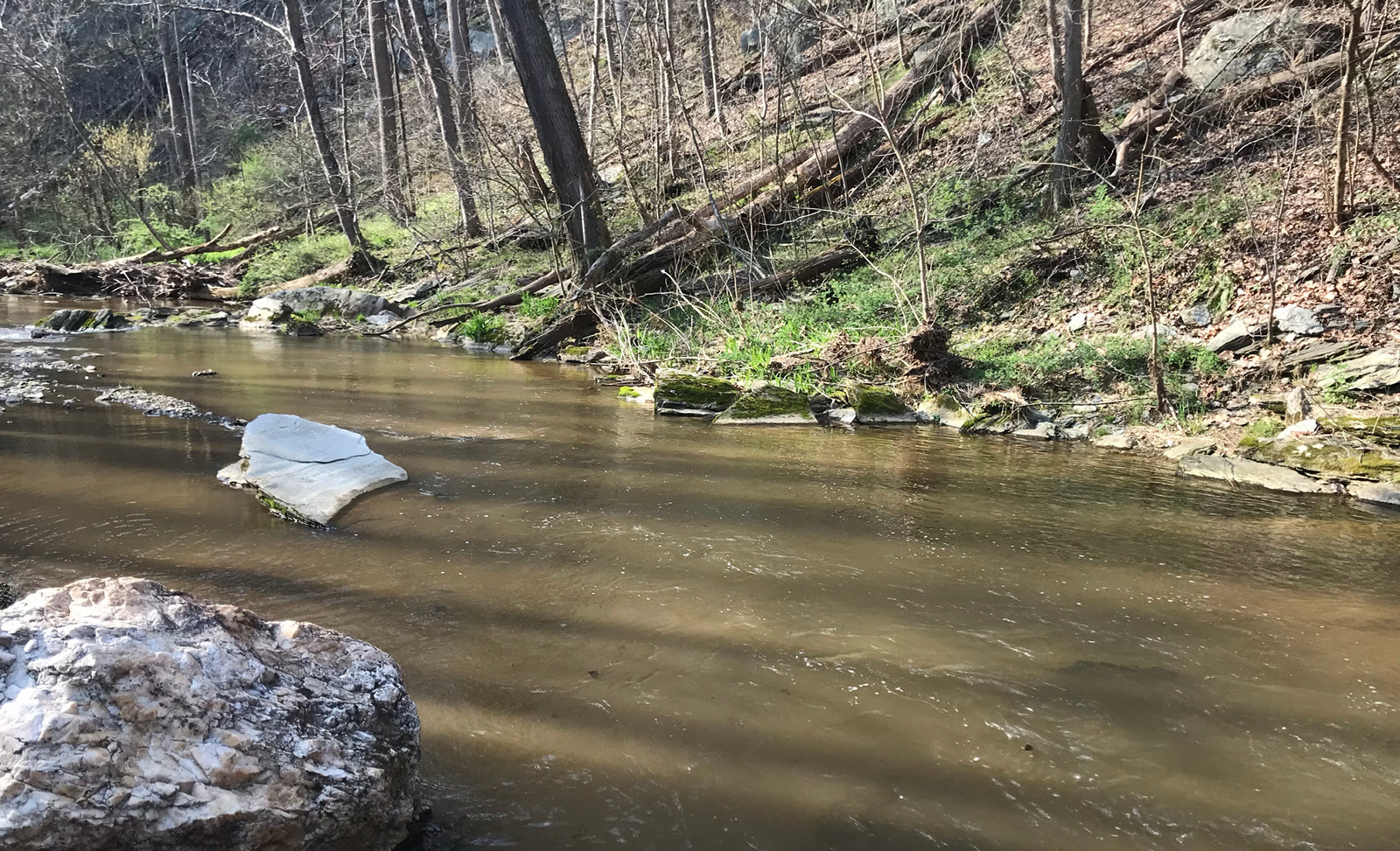 Fishing Creek choked with sediment from illegal four-wheeling.
Fishing Creek choked with sediment from illegal four-wheeling.Most of the people visiting Fishing Creek were in some form of 4-wheel drive vehicle. A few walked down the road or up the trail to the top of the ridge. But most drove on the road. Fishing Creek is known as a 4-wheeling destination, really the only one in the area. But it isn’t. It is essentially an unmaintained dirt road where large puddles form along its edges. If you steer your truck off the road just a bit you can get a bit more mud on your fenders, and maybe get splashed with dirty water if your top is off. The problem is these minor barely off the road detours cause significant damage to the thin forest between the road and creek, and the muddy water that spills into Fishing Creek from the puddles chokes the life that lives there. The damage is so severe it is now illegal to 4-wheel along Fishing Creek Road. The Lancaster Conservancy owns and manages Fishing Creek preserve and their staff educate folks about the ecological and legal hazards of 4 wheeling here. I watched a line of SUVs and pickups roll down the road as I walked into the creek bed.
I stepped around the Lilliputian forest of may apple umbrellas that just recently pushed through the duff, and made sure to step over the white dainty spring beauties as I hopped onto the tan gravel bar made up of individual orange, amber and red pebbles all laced with mica. Clear water flowed over the sharp fins of schist bedrock that transverse this little stream. Part of the draw of this place, like most Susquehanna Riverlands streams and preserves, is their dramatic geography, steep sided gorges where streams cut through the underlying geology of Wissahickon schist, a kind of metamorphic rock, a deposited mud stone or shale made beautiful by heat, pressure and time. The streams that traverse through this geology cause dramatic geography like steep sided gorges and are part of the magic of the Susquehanna Riverlands region.
I entered Fishing Creek right where it had worn through one of these ancient spines of rock. A tangible example of a well-known passage in Job which also happens to be a Chinese proverb, and a good lesson for today: water wears away rock. Persistence. Grit.
Fishing Creek was beautifully clear and her background reflected quicksilver amber off the underside of her surface. The sharp fins of schist that jutted into the stream bed were covered in a thick coat of furry olive-green algae. Pretty typical for this time of year when sunlight increases with longer days but the canopy hasn’t grown in yet to shade the creek, so algal growth goes nuts. Of course, the constant contributor is too much nutrient coming from farm field and lawn. Too many nutrients cause too much algae to grow, a condition called eutrophication, and all of the waterways in our region are eutrophic to some degree.
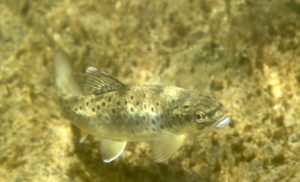
Brown trout
Two brown trout pointed head up into the current at the head of the pool where the water spilled through the schist. These were hatchery fish, I’m sure, but still majestic in form and presence. They owned this pool as its top predators, barring intervention from a heron or eagle. Their gold and red spots glowed and their eyes showed their awareness of the creek, and how I was an intruder – fixated on me while constantly monitoring the water that flew by for food. So wary, and aware, constantly evaluating, deciding to stay or go, until the threat of my presence outweighed the benefit of watching the flow stream past for the errant mayfly plucked from the bottom by the current and cast into the drift. Easy pickings for a brown. They shot upstream faster than I could track. Such agile aquatic athletes. The rosyside and the blacknose dace were the real show, though. These are common fish. Just part of the non-descript “minnow” category we place on the small fish in a creek we really can’t identify than anything more than a “minnow”. Granted, when viewed from the surface they all look pretty similar. Pretty ingeniously camouflaged as the brown bottom of the creek. But when viewed from under water they are so brilliant!
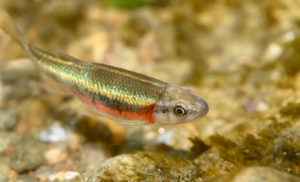
Rosyside dace
Rosyside dace have vivid red sides all year long, but they become especially intense now just before the spawn. Their red sides glow bright while the fins and heads on male rosysides turn almost turquoise blue. They will get small powder blue bumps called tubercles on their heads which give them a halo appearance. The females are just as dazzling with crisp red sides and clean tan on the rest of their bodies. They jostle in the current, not quite spawning, but I think sizing each other up, warming up to when it is time to spawn. Like the brown trout, these fish navigate the strong current masterfully, and I watch individual fish spot food in the water, target it, strike out and return back to the same position they held in the stream. While considered globally secure and a species of least concern in terms of conservation, rosysides have been extirpated from parts of their range, we think due to increased sedimentation. While some individuals only tolerated my presence for so long (although more than the brown trout) others were as curious about me as I was about them and they watched me back. One little male stayed put in the lee of a bedrock fin by barely moving his tail. His side was swathed in a bright crimson swatch beneath a black stripe. Above that I could see the black outlines of each of his iridescent gold green scales. His head hadn’t sprouted tubercles yet, and I wondered if maybe he was too young for them.
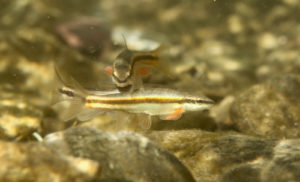
Blacknose dace
The blacknose dace weren’t too interested in eating. Two or three smaller males chased a larger female rapidly upstream until she stopped in the lee of a quartz cobble. The two males frantically worked to get her attention and prove they were the most fit suitor by flaring their orange pectoral fins. They seemed to expand the orange stripe on the side of their body, that runs just above the black one. It was as if they were puffing out their chests, but that might have just been my perception and how the fish turned broadside to the sun so that they glowed. These are always beautiful fish, with very crisp solid black stripes that run the entire length of their bodies from nose to tail, and divides them into a wonderful gold/silver back above and white cream abdomen below. The males add orange now to impress the females, we assume. There were groups of male and female blacknose dace sprinkled all throughout the creek, depositing and fertilizing eggs.
A male tessellated darter poked his nose out of his protective crevice to see what was going on. Darters live on the bottom and tessellateds are some of the most common. I hoped to see another kind of darter, the Chesapeake logperch, which is only found in this part of the world. Logperch are large for darters, 5 or 6 inches. They are striking fish – tiger striped and brilliant. They flip rocks with their pointy snouts to look for insect meals. They are considered globally vulnerable due to their limited range. Susquehanna Riverlands streams provide a stronghold for the species, but if something happens even to just one stream, a herbicide leak or sediment spill for example, an entire population could be wiped out.
I watched the darters, rosyside and blacknose dace ply the current, and use it to their advantage. I watched them make decisions about nabbing a piece of food or not, decisions about coming in close to investigate me as I watched and photographed their beauty. Finally, I got out of the creek content and privileged to have witnessed such beauty and intensity, to experience the continuation of a species. I heard a low rumble come from upstream and the water turned from almost crystal clear to chocolate milk brown. Then the ATV appeared, driving down the middle of the stream.
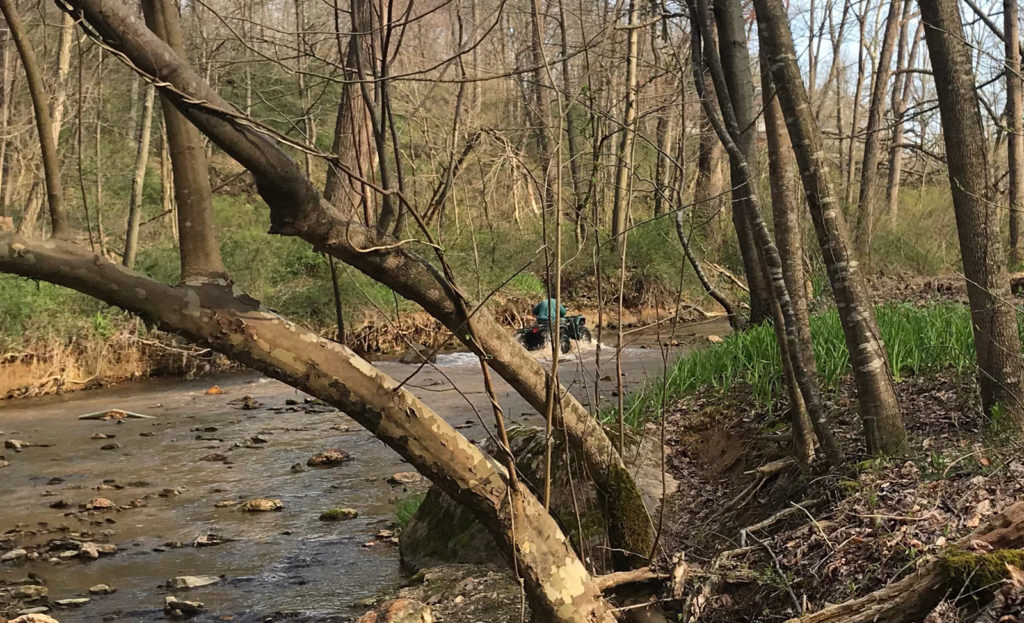
I was instantly infuriated. The water became more choked with mud the closer the machine got. The driver stopped when he saw me, turned around and headed back upstream. I thought of all the life he impacted, just this one person. All of the trout, dace, and darters. All of the beauty they represent. How the sediments he was throwing into the water were choking gills and smothering recently fertilized eggs, far downstream from where he was riding. I thought about the physical harm he was causing to habitat, and possibly even individual fish not able to get out of his way in time. Just one person is able to ruin so much in such a short amount of time. But I don’t think this guy intended this. He didn’t ride thorough the creek to purposely cause harm. He just rode through it for fun, without thinking of the consequence. I really don’t think this person meant to damage this creek.
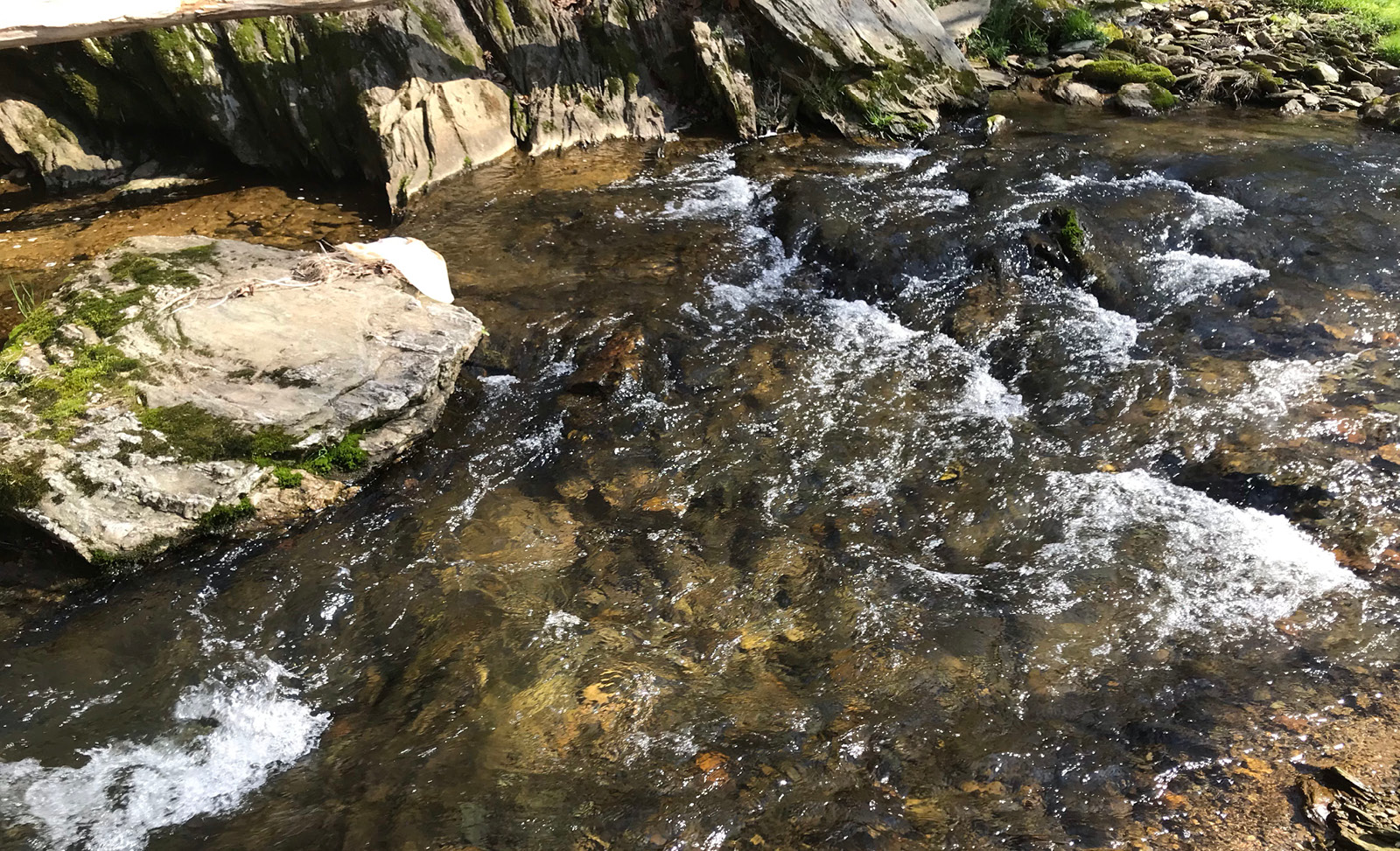 Before.
Before.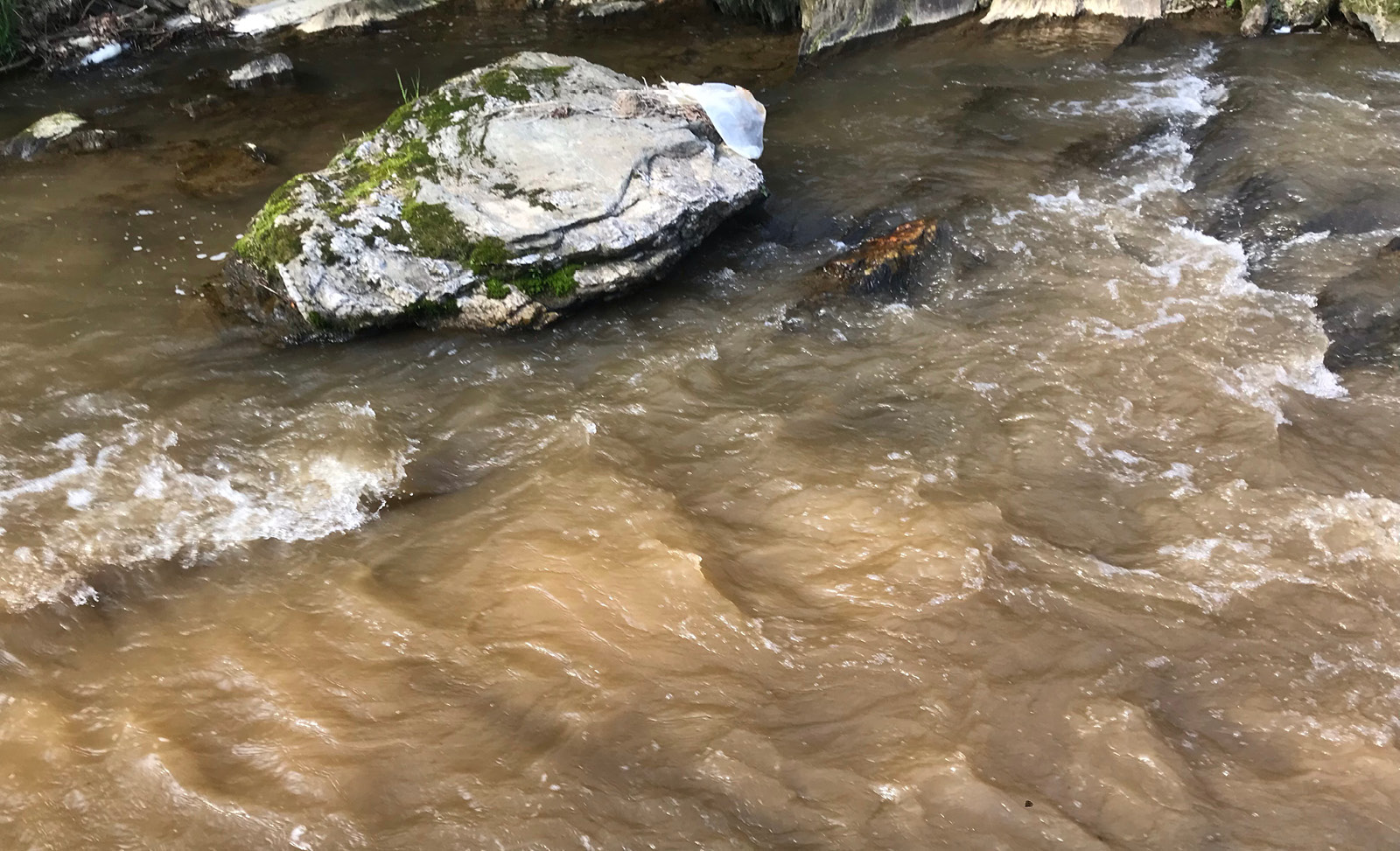 After.
After.It’s unintended consequences. People who plough through the large puddles along Fishing Creek don’t mean to push all that filth into the clear waters of the stream. They don’t mean to choke the life out of the dace and darter eggs, or clog trout gills. The guy riding through the middle of Fishing Creek, I don’t think, intended to harm the beauty there – he was just out for a joy ride. But his joy ride had the unintended consequence of throwing a ton of sediment downstream. The same concept of unintended consequence applies to people who make unnecessary trips to the store, or those who make necessary trips without a mask. They don’t mean to spread the disease to members of our community who can’t fight it, but they do. People who visit preserves that are at capacity don’t intend to damage nature there, but they do. There is a positive corollary here. If just one person can have such a negative effect, then just one person can have just as much of a positive one. Just one person can help protect others in our community by limiting trips to stores and wearing a mask when they go out. Just one person can help protect preserves by not visiting when they are full. Just one person can help protect open space for our community by donating to the Lancaster Conservancy and by volunteering.
I returned the next day and snorkeled Fishing Creek again. The impacts of the ATV were still etched into the stream bottom but the water had cleared and the blacknose dace were just as frisky. A Conservancy truck pulled up and a masked preserve manager got out. “I’m placing flags for a tree planting we are planning to help protect the creek,” he said. Just one person.
